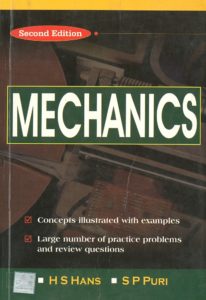
Harnam Singh Hans
(21st Nov., 1922 - 19th March, 2014)
Mechanics
Preface to the Second Edition

In the last couple of decades. the teaching and syllabi in undergraduate Physics have
undergone a major change, initiated years back by ULP-COSSIP programmes of
UGC. The first edition of this book, written against this background, was essentially
based on a conceptual approach to Physics; containing only the essential parts,
without attaining comprehensiveness required to teach a modem syllabus in Mechanics. However, even the first edition was widely accepted, resulting in 13 re-
prints from 1984 to 2001. But our attention was frequently drawn to the need of
another edition of the book, comprehensively incorporating all topics as prescribed
in the syllabi of a majority of the universities. This edition is a result of the revision
in the light of this need, even while maintaining the philosophy of conceptual ap-
proach to the teaching of Physics.
In this edition, the scope and organisation of the original has been retained by and large; while adding or rewriting a number of sections which required clarity and
simplicity. It reflects essentially threefold effort on our part; the refinement and
improvement of the material in the original, addition of three more chapters, and
emphasis on the application side by including more solved and unsolved prob-
lems.
Chapter 2 on Vector Algebra was made more comprehensive by changing it into
Vector Analysis through the shifting of Appendix B as well as adding an article on
Gauss’s divergence theorem. In Chapter 4 on Particle Dynamics, the equation of
motion for a variable mass was incorporated by including the motion of a rocket.
In Chapter 6 on Inverse Square Law Force an obvious and serious lacuna was eliminated by the addition of gravitational potential and field along with the parallel cases of electrostatic potential and field. This lays the foundation of the classical theory of fields.
The theorems of perpendicular and parallel axis were added on Chapter 8— Dynamics of Rigid bodies—for aiding the student in learning the subsequent material. The scope of Chapter 9 on Oscillatory Motion has been improved by including additional examples of S H M, i.e., Loaded Spring, Torsion Pendulum, Compound Pendulum, Helmholtz Resonator and L C circuit, as representatives of mechanical
and electrical oscillations. Also included are the topics: resistance damping, electro-magnetic damping in a moving coil galvanometer and electrical resonance.
In Chapter 10 on Frames of Reference, a few articles have been recast for making the presentation clear and simplified. The occurrence of trade winds and cyclones due to Coriolis force, have been illustrated with diagrams with a view to make it easily graspable. An article—Experimental Evidence for Special Theory of Relativity, has been added in Chapter 12.
The new chapters added in this edition include (i) Charged Particle Dynamics (ii) Lagrangian and Hamiltonian Formulations, and (iii) Mechanics of Continuous Media.
The Article 12.4.1 on charged particle dynamics was enlarged to a full-fledged chapter in view of the requirements of the prevalent syllabi. Lagrangian and Hamiltonian formulations are introduced with a view to acquainting the reader with the canonical formulation of the dynamical equations. This topic finds a mention in the syllabus of Panjab university. The last chapter on Mechanics of Continuous Media comprises the topics: Elasticity and Fluid Dynamics. These constitute an essential part of the syllabus for B.Sc. students of Delhi University as well as U P Universities. Their inclusion was required, so that the book caters to the requirements of B.Sc. students as well.
Furthermore, about 92 more solved problems have been interspersed throughout the book, in addition to over 80 unsolved problems with answers.
We feel incumbent upon us to express our heartfelt appreciation for all the help and initiative on the part of Mr Tapas Maji, in making available the referee’s reports on the book. These were tremendously useful and served as beacon lights in removing some minor errors and simplifying the presentation at a number of places. He was always so prompt in his replies that it was a charm to work with him.
Lastly we feel grateful to the production department of Tata McGrawHill Publishing Company m general and to Mr Raza Khan in particular for extending all assistance in making it error free and achieving high quality of production.
An all out meticulous care was taken to make the presentation as free of errors as possible but as authors we own the entire responsibility for any residual errors of omission or commission that may still be lingering in the text. We heartily welcome any suggestion or criticism from the readers towards the improvement of the text. These will be gratefully acknowledged.